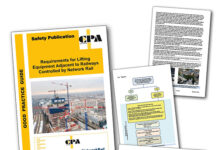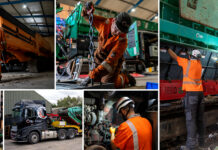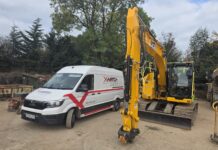THERE were 144 work-related deaths in the last year, according to a recently published HSE report. The most common cause of death was a fall from height (35), with the construction sector recording the largest number of deaths by industry (38).
The inherent risk of working at height is only exacerbated by the use of heavy machinery, so operator safety is paramount. With this in mind, Project Plant spoke to designer, manufacturer and supplier of safety products, MSA Safety, about its range of solutions designed for use with mobile elevating working platforms (MEWPs).
MSA Safety has developed a range of mini personal fall limiters (PFL) that not only exceed the requirements of national standards but have also been fully tested for use with MEWPs, and designed to protect the user if they are ejected from the basket while moving around a site. The company also manufactures self-retracting lanyards (SRL) and personal rescue devices (PRD).
“What this does is it gives a user the ability for free movement within the basket but in the event of an ejection the PFL locks on and keeps that user within the basket,” explained Andrew Pass, global engineering manager for fall protection engineered systems at MSA Safety.
“The elements you need to take into consideration are the anchor point within the MEWP and the identification that if you do fall out of the basket you’re going over a double edge, which can affect the integrity of the lifeline that you are attached to.
“The MSA PFL has been developed and tested with this in mind with a special lifeline webbing to protect itself against that double edge that you see in a MEWP basket, whilst maintaining the load back to the anchor point, sufficient to be safe.”
Andrew said the company prides itself on understanding the application of its products. “We look to develop a product that not only services the user, but we undergo stringent tests to understand that specific application and ensure integrity and durability of the product.”
Andrew highlighted the PFL’s clear casing, which allows the user to inspect the product easily, along with its internal radial energy absorber that is housed within the body of the product.
“This is a product that doesn’t need annual recalibration of the energy absorber, and equally, compared to competition, it’s protected within the case so that it doesn’t get damaged,” he said.
There are different challenges in every application of fall protection, Andrew said. “With respect to powered access, that covers quite a broad range of machinery and equipment, from direct vertical elevated work platforms to extended booms to differing applications.” Andrew went on to explain that the French fire service is utilising the PFL for free access at the top of its ladders to give them access in and out of burning buildings, where heat integrity is a vital consideration.
James Sainsbury, MSA’s UK sales leader for fall protection said the company was in talks with MEWP manufacturers about the PFL being specified as a “product of choice” for fall protection, along with the company’s PRD, which lowers the user to the ground safely following a fall.
He added, “We’re also kitting up these solutions so a hire centre or an end customer can effectively buy a bag that contains everything they need so they’re not worrying about whether it’s the right harness, whether it’s the right length lanyard, whether it’s the right PFL. It’s all in the bag, which again simplifies the solution to the customer.”
Andrew said that safety equipment could also be considered for the hire market. “MEWPs are a typical hire product and the use of the self-retracting lanyard in the hire market removes the level of technical understanding required to utilise the safety equipment i.e. trying to make it as simple as possible.”
The biggest unconsidered risk, in Andrew’s view, with regard to fall protection and MEWPs, is driving the equipment with the arm at full stretch. The further the arm is stretched from the anchorage base, he said, the higher the chance of ejecting the user.
“The best tip is to move the MEWP with the arm fully in, where you have the greatest control.”
Andrew said something the company was “driving hard” was removing the need to understand the application for the product, rather than the product itself. “We are looking at developing and launching products – and in particular PFLs and SRLs – which are compatible with each application; so, falling over an edge, rather than having to consider your application.”
He added, “The real message from a technology development standpoint is our forward-looking strategy of simplifying fall protection and engineered systems within fall protection.
“As mentioned, there’s previous history of needing to really and technically understand the application, the correct products to tie up with and the components to put together to make the scenario safe. We’re striving to remove that necessity and make our products as easy and as safe for people to help minimise the risk of accidents.”












